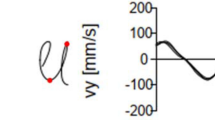Abstract
Poor handwriting in hyperactive children often contributes to academic failure. Beneficial effects of methylphenidate on the quality of handwriting have been shown. Using a digitizing tablet, the handwriting of 21 hyperactive boys was examined both during methylphenidate treatment and following withdrawal of the drug. Half of the hyperactive boys were tested first on methylphenidate and then following withdrawal of the drug and the remaining hyperactive boys were examined in the reverse order. Twenty-one control boys underwent the same examination. Velocity and acceleration of handwriting movements were measured. Furthermore, every writing specimen was independently rated by four examiners regarding the quality of handwriting. Following withdrawal of the drug, the quality of handwriting specimens of hyperactive boys was poorer than during treatment with methylphenidate. Statistical comparison of writing movements of hyperactive boys on and off methylphenidate revealed that the medication resulted in a deterioration in handwriting fluency. The results showed that following withdrawal of medication, hyperactive children did not differ from control boys in handwriting movements. The improvement in hyperactive behavior through methylphenidate was associated with increased legibility and greater accuracy of handwriting. The intention to write neatly may interfere with the fluent writing process.
Similar content being viewed by others
REFERENCES
Ackerman, P. T., Anhalt, J. M., Holcomb, P. J., & Dykman, R. A. (1986). Presumably innate and aquired automatic processes in children with attention and/or reading disorders. Journal of Child Psychology and Psychiatry, 27, 513-529.
American Psychiatric Association (1987). Diagnostic and statistical manual of mental disorders. (3rd ed.). Washington, DC: American Psychiatric Association.
Barkley, R. A. (1998). Attention-deficit hyperactivity disorder. Scientific American, 9, 45-49.
Eichhorn, T. E., Gasser, T., Mai, N., Marquardt, C., Arnold, G., Schwarz, J., & Oertel, W. H. (1996). Computational analysis of open loop handwriting movements in Parkinson's disease: A rapid method to detect dopamimetic effects. Movement Disorders, 11, 289-297.
Goyette, C. H., Conners, C. K., & Ulrich, R. F. (1978). Normative data on revised Conners Parent and Teacher Rating Scales. Journal of Abnormal Child Psychology, 6, 221-236.
Hoza, B., & Pelham, W. (1993). Attention-deficit hyperactivity disorder. In R. T. Ammerman & C. G. H. M. Last (Eds.), Handbook of prescriptive treatments for children and adolescents (pp. 64-84). Boston: Allyn and Bacon.
Kubinger, K. D., & Wurst, E. (1985). Adaptives Intelligenz Diagnostikum (AID) [Adaptive Intelligence Battery]. Weinheim, Germany: Beltz.
Lerer, R. J., Artner, J., & Lerer, M. P. (1979). Handwriting deficits in children with minimal brain dysfunction: Effects of methylphenidate (Ritalin) and placebo. Journal of Learning Disabilities, 12, 450-455.
Mai, N., & Marquardt, C. (1992). CS—Computer-assisted movement analysis in handwriting. Operational manual. Munich, Germany: MedCom Verlag.
Mai, N., & Marquardt, C. (1994). Treatment of writer's cramp. Kinematic measures as an assessment tool for planning and evaluating training procedures. In C. Faure, P. Keuss, G. Lorette, & A. Vinter (Eds.), Advances in handwriting and drawing. A multidisciplinary approach. Paris: Télécom.
Näätänen, R. (1992). Attention and brain function. Hillsdale, NJ: Lawrence Erlbaum Associates.
Peeples, E. E., Searls, D. T., & Wellingham, J. P. (1995). Attention-deficit hyperactivity disorder: A longitudinal case study of handwriting characteristics. Perceptual and Motor Skills, 81, 1243-1252.
Resta, S. P., & Eliot, J. (1994). Written expression in boys with attention deficit disorder. Perceptual and Motor Skills, 79, 1131-1138.
Seidman, L. J., Benedict, K. B., Biederman, J., Bernstein, J. H., Seiverd, K., Milberger, S., Norman, D., Mick, E., & Faraone, S. V. (1995). Performance of children with ADHD on the Rey-Osterrieth complex figure: A pilot neuropsychological study. Journal of Child Psychology and Psychiatry, 36, 1459-1473.
Thomassen, A. J. W. M., & van Galen, G. P. (1992). Handwriting as a motor task: Experimentation, modelling, and simulation. In J. J. Summers (Ed.), Approaches to the study of motor control and learning (pp. 113-144). Amsterdam, The Netherlands: North-Holland.
van Galen, G. P. (1991). Handwriting: Issues for a psychomotor theory. Human Movement Science, 10, 165-191.
Whalen, C. K., Henker, B., & Finck, D. (1981). Medication effects in the classroom: Three naturalistic indicators. Journal of Abnormal Child Psychology, 9, 419-433.
Author information
Authors and Affiliations
Rights and permissions
About this article
Cite this article
Tucha, O., Lange, K.W. Effects of Methylphenidate on Kinematic Aspects of Handwriting in Hyperactive Boys. J Abnorm Child Psychol 29, 351–356 (2001). https://doi.org/10.1023/A:1010366014095
Issue Date:
DOI: https://doi.org/10.1023/A:1010366014095




